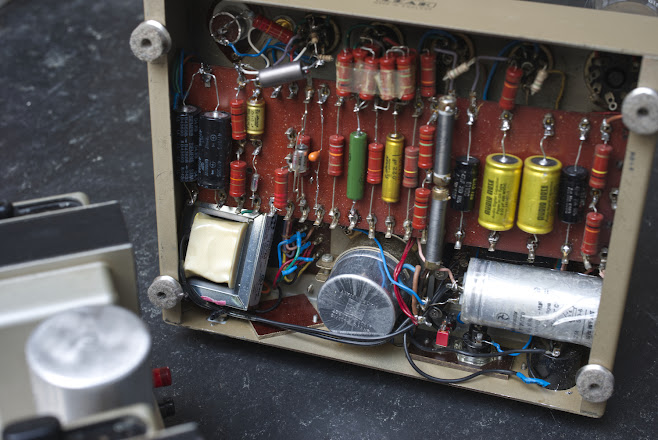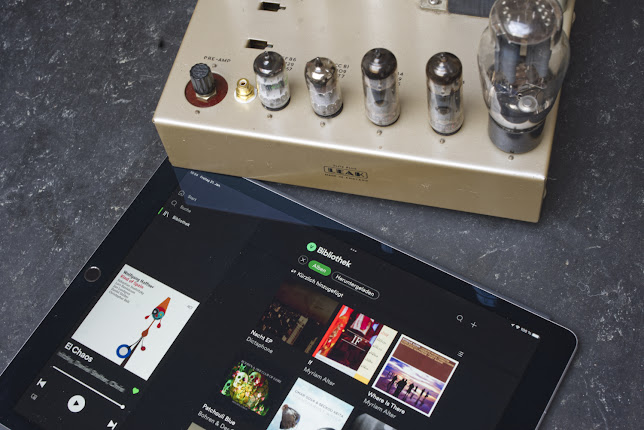As already widely shown in my earlier articles I collected in the early 1990ties during my London time a whole lot of classic Leak tube amplifiers. Foremostly I remember one visit in London in 1992 when I did buy an exceptional lot of amplifiers from London dealers. On the way back to Germany my car got stopped from French custom officers because of its obvious visible overweight in its trunk, the rear wheels already were deep hidden in the chassis with an extra 15º camber. I will never forget the officers face when I did show him the tight stacked amplifiers, he had no idea what he was looking at. I don't exactly remember, but it must have been around 6 to 8 pairs of this model TL12+ and several Stereo 20 and as well some pairs TL10.1 and TL12 point one's. I tried to explain that these are historic audio amplifiers, but he hardly could believe my words looking at a wall of golden chassis.
 |
| The classic late 1959 Leak TL12+, here already with RCA-socket and input pot. |
The shown pair is one set of this batch. I did restore all of them to my highest possible standard these days. In particular this pair got the best care because of the rather rare color "champaign" and with the aim to keep them for my own collection. As regular treatment I replaced the electrolytic filter caps to oil caps. Here the old electrolytic content needed to get emptied in order to reuse their cans for originality and color with new caps glued in. Generally all coupling caps where replaced to oil caps, a expensive step these days because the only modern source for such was Audio Note, who cared about the distribution of Jensens Audio Caps, a good 20£ investment for each value which added alone to 200£ for a set. All carbon composition resistors got exchanged to new German Beyschlag 2 watts carbon composition types, each around 2 € only available in 10er belts these days. The cathode bypass capacitors generally got changed to bipolar tone frequency caps, which mainly where used as crossover parts in speakers. The religion in these days was the use of triodes in all stages, so I always changed the input stage from EF86 pentodes to ECC83 triodes in order to refine the soundstage and to reduce the input amplification factor, which is with all Leaks extremely sensitive. I brought generally the power stages of these push-pull designs to semi triode operation of the EL84 tubes. All these steps were introduced in order to achieve with this little amps a much more sophisticated and smoother operation, in contrast to the impressive, but a bit too cheaky performance of the original version. The reduction of output power from 12 watts to hardly 4 watts in pseudo triode operation emotionally perceived with efficient speakers (better than 96db) as to be a even better drivability.
 |
| Close up of input stage in foreground, in background whole lot of modifications at the filter stage with smoothing choke (at left) and fuse holder, switch (at right) and power cord. |
As some might expect the days weren't far that I decided, with almost every Leak model in daily use, the most of them in several versions, to get rid of some doublets to save space and money. Some friends of mine got within this years involved into my passion and became interested as well to use tube amplification in combination with Tannoy speakers. So I sold some amps from my collection to them. As reported in my last entry a Leak Stereo 60 of my early collection revisited me unexpected end of last year. This example found a caring new home in the meanwhile. Shortly before New Years Eve another friend visited me and brought another former pair into service, which acted for 30 years a long term companion to his Tannoy Lancasters with 15'' Monitor Golds for him. When I started to inspect this pair, I realized what 30 years of rough use with several house moves and more or less permanent plugging and unplugging can do. They were completely rocked down. Loose contacts, open wires, leaking capacitors, wax dripping from transformers, tubes run down to 20%, in one an almost black ashed rectifier tube showed the remnants of an unexpected firework, – he had treated them almost to unusable wracks. My friend decided to spend good money for another life and a total revision. At my first restoration in 1992 these amps were already 35 years old, now added on to another 30 years. I will try my best to give them another third life for the next 30 years. Maybe these little wonders will find one day when I already will be passed away the next owner who might bring them into a fourth period of living – this is what I will call sustainability – not the highly acclaimed class G digital amps to be so.
 |
| View of the complete mainboard, just at top edge underside of pot and the filament symmetry element |
For this reason to open up for a new future I decided to change some principles I had 30 years ago. I always took extremely care to keep mechanical originality of the amplifiers, which was meant not to drill wholes or remove unused components, like the octal sockets for chaining further Leak- or other components. Today or even better tomorrow nobody really will use a Troughline tuner or a Varislope preamp, so contemporary preferences for practical use are getting more important instead of originality. A better control of the input signal, in particular with modern high output components (min. 2V or more) like preamplifiers, computers or digital streaming clients, – more or less hum- and hiss free operation and of course still the smooth and dynamic soundstage are relevant for the aficionado.
So I needed to find mechanically and electrically matching filter capacitors as paper-in oil types, not an easy job even with eBay within such sizes. Pots, switches and simple things like fuse holders are more and more difficult to be found in well known high quality, foremost made for military use in the 1970ties.
 |
| Knob inlay made from real embossed calf leather matching luxury expectations... |
The Leaks got now smoothing chokes (8H/100mA) in the filter stage, NOS mil spec input potentiometers, perfect RCA-sockets, switches, optimized AC-cords and of course a set of best possible NOS tubes in every stage. So equipped this little pair will do a perfect job in the coming years and play now in the same league where best handmade tube amplifiers like Shindo, Thomas Mayer or others are bought for in difference to modern chrome monsters made to match Asian expectations.
 |
| 60 years of technological time shift to play music |
Now this little amps are ready for the time which is already there, a time were music streaming has overtaken the music market and digital components are feeding their playlists into such ultra analog audio chains. After 10 years of wireless music stream into my own chain from my notebook as to be the 'jack of alle trades'. I did spend at the start of 2022 myself an actual iPad with 1Tb storage to be solely my comfortable music juke box to play from cloud services as well from my own digital collection at a finger touch.
Stay healthy, it might find an end sooner or later, Volker
